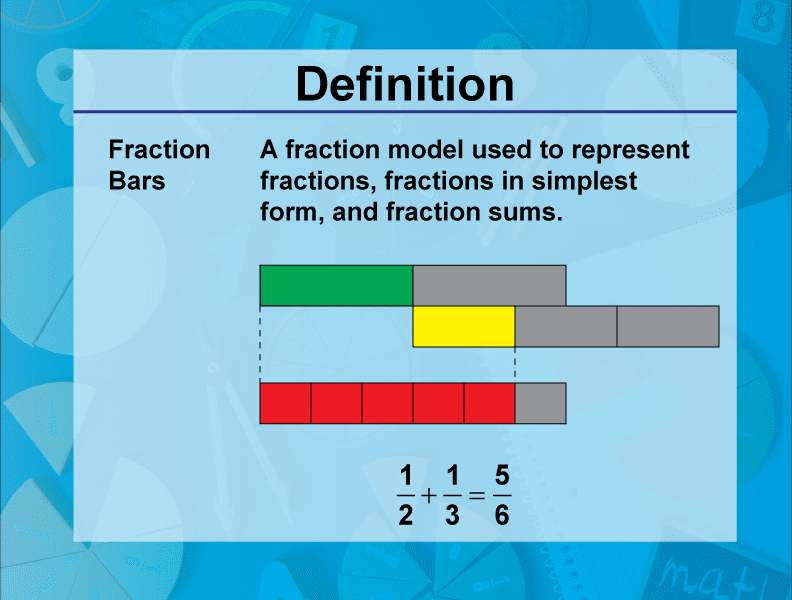Excelling at Utilizing fraction bar in Numerical statements

Fraction bars, otherwise called division strips or part tiles, are significant apparatuses in the domain of math, especially in understanding and working with parts. These visual guides give a substantial portrayal of partial connections, making complex ideas more open and working with critical thinking. Whether in study halls or at home, excelling at involving part bars can upgrade understudies’ perception and capability in handling many numerical issues. In this article, we will dive into the basics of division bars and investigate methodologies for actually using them to overcome different number-related difficulties.
Understanding Division Bars:
- Portion bars comprise sectioned strips or tiles, each addressing a negligible part of an entirety.
- Normally, these bars are variety-coded or named to mean different fragmentary qualities, permitting clients to analyze and control divisions outwardly.
- For instance, a part bar might be separated into equal parts, thirds, fourths, fifths, etc, contingent upon the ideal degree of granularity.
- One of the essential benefits of division bars is their capacity to outline fragmentary connections substantially and naturally.
- By outwardly dividing an entire into two halves, understudies can embrace ideas like identical portions, expansion, deduction, duplication, division, and correlations with more prominent clearness.
- Also, division bars act as successful apparatuses for critical thinking, empowering understudies to envision tasks and foster vital ways to deal with and tackle numerical conditions.
Techniques for Using Division Bars:
1. Figuring out Identical Portions:
Portion bars offer a unique stage for investigating comparable parts, which are divisions that address a similar amount notwithstanding having various numerators and denominators. By overlaying division bars of various lengths and noticing their arrangement, understudies can recognize examples and connections between parts. For example, adjusting a half-length bar to two 33% bars shows the equality between 1/2 and 2/3, building up the idea of comparable divisions through visual exhibition.
2. Adding and Deducting Portions:
With regards to adding or deducting divisions, portion bars give a clear technique for consolidating or looking at partial amounts. To add divisions utilizing portion bars, understudies can adjust bars of a similar length evenly and count them all out number of sections to decide the total. Essentially, for deduction, understudies can outwardly address the deduction cycle by eliminating fragments from the first division bar. This active methodology cultivates a more profound comprehension of portion expansion and deduction by solidly showing the ideas in question.
3. Increasing and Isolating Portions:
Portion bars likewise work with duplication and division of parts by giving a visual portrayal of the tasks in question. To increase portions, understudies can overlay part bars upward and notice the convergence focuses to decide the item. For division, portion bars can be utilized to exhibit the idea of separating an entire into partial parts, assisting understudies with imagining the connection between the profit, divisor, and remainder. By controlling part bars, understudies can foster a reasonable comprehension of portion duplication and division, preparing for familiarity with tackling related issues.
4. Contrasting Divisions:
Division bars help in contrasting portions by empowering understudies to outwardly evaluate the overall sizes of various parts. By adjusting division bars next to each other and noticing their lengths, understudies can instinctively figure out which part is bigger or more modest. This visual way to deal with division examination supports the idea of comparable parts and gives a substantial premise for grasping portion disparities. Moreover, part bars can be utilized to arrange portions on a number line, further improving understudies’ spatial thinking abilities and theoretical comprehension of divisions.
5. Critical thinking Applications:
Past fundamental number juggling tasks, and part bars can be applied to settle many numerical issues across different areas, including math, polynomial math, and certifiable situations. Whether computing areas of mathematical shapes, tackling conditions including divisions, or deciphering information in graphical portrayals, part bars offer a flexible device for conceptualizing and taking care of complicated issues. By coordinating portion bars into critical thinking exercises, teachers can advance decisive reasoning, numerical thinking, and pragmatic use of part ideas in different settings.
Final Thought
Excelling at utilizing fraction bars isn’t just about controlling visual guides; it is tied in with fostering a more profound comprehension of fragmentary ideas and improving critical thinking abilities in math. By utilizing portion bars to investigate identical divisions, perform number-crunching tasks, analyze parts, and tackle true issues, understudies can upgrade their numerical capability and certainty. As teachers and students the same hug the adaptability and viability of division bars in the homeroom, they engage understudies to open the groundbreaking capability of parts in math and then some. With training, tolerance, and constancy, excelling at utilizing division bars becomes feasible as well as enormously compensating in molding numerical proficiency and cultivating a long-lasting appreciation for the excellence of math.





